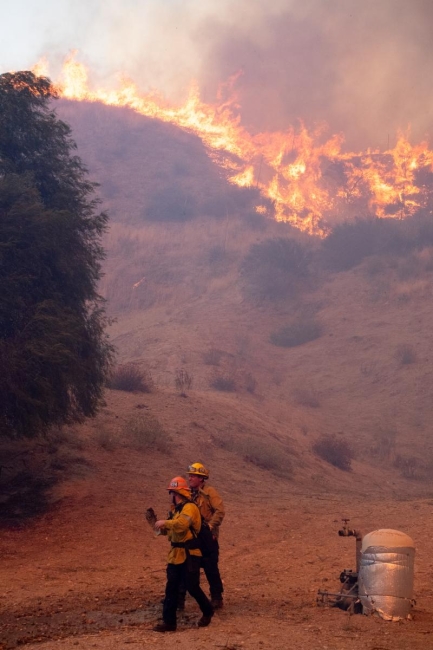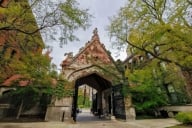You have /5 articles left.
Sign up for a free account or log in.

Fire burns in California.
Getty Images
What is the basis for collaboration between a premier public university and a world-renowned graduate theological consortium? What brings together a small, private graduate school of religious studies with a large, comprehensive state university? The simple answer: the air we breathe.
When I moved to Berkeley, Calif., from the greater Boston area in the summer of 2018 to become the eighth president of the Graduate Theological Union -- an interreligious graduate school offering a Ph.D., master’s degree and certificates in religious studies, as well as a consortium of 12 seminaries and affiliated institutions -- I did not imagine I would have to contend with climate-induced campus closings. After all, I was leaving behind nor’easters for a dream of endless sunny skies.
But the past two years have demonstrated that this dream is poised to die. For the second time this year, the institution and its close neighbor, the University of California, Berkeley, have had to wrestle with campus closures due to the effects of what is coming to be known as “fire season” in Northern California. An article in The New York Times recently characterized that season as the result of climate change, signaling the “end to California as we know it.” Among the season’s maleffects are poor air quality, electrical outages, temporary or permanent homelessness for many people, or worse.
As different as our institutions are -- private vs. public, theological vs. secular -- we share the same air, and we are increasingly put in the position of contending with the demise of our much beloved natural environment.
The relationship between our two institutions runs much deeper, of course. For decades, we’ve had a reciprocal relationship that has produced cross-registration agreements, library collaborations and even joint Ph.D. programs.
But there is something different in the air besides the smoke that has tragically forced our faculty, students and neighbors to don masks and necessitated closing GTU and Berkeley for several days. Both of our institutions are committed to applying the rich intellectual resources and talent within our faculty and student bodies to the critical challenges we confront as a society. The zeitgeist is demanding that universities and theological schools work in tandem to bring about the kind of intellectual, spiritual and practical transformation that requires new forms of synergy and collaboration.
The environmental crisis we face as a result of climate change and the concomitant decline in biodiversity demands a partnership between science, public policy and religion. E. O. Wilson, the Pulitzer Prize-winning Harvard University biologist, writes in his compelling book, The Creation, that “religion and science are the most powerful forces in the world today, including especially the United States. If religion and science could be united on common ground of biological conservation, the problem would soon be solved. If there is any moral precept shared by people of all beliefs, it is that we owe ourselves and future generations a beautiful, rich and healthful environment.”
I am not so sure that the problem can be solved as quickly as Wilson suggests, but I am convinced that the collaboration between science (and here I include the social sciences) and religion can be a powerful source of strategic change in response to the apocalyptic reality that we humans have created. We need both the moral imagination and normative motivation that religion can generate on a mass scale as well as the detailed analysis and problem-solving inventiveness of secular science.
At our institution, we have launched academic programs and conferences that focus on interreligious perspectives on sustainability. We are collaborating with scholars across disciplines and institutions, including public universities like Berkeley, to reimagine our world so that we can preserve it as a blessing and a precious gift to our progeny.
A few weeks ago, I met with top leaders, including the dean, of one of Berkeley’s graduate schools, the Goldman School of Public Policy. The energy in the room as we discussed potential areas of collaboration was electrifying (and did not need to be shut off, only turned up). How can we partner to bring diverse religious-ethical perspectives to public policy issues? In what ways can interreligious knowledge help policy makers better understand people’s diverse worldviews and perspectives on policy issues? How can religious scholars and leaders deepen their theological thinking by engaging with real-world policy challenges and solutions?
As one example of collaboration, the GTU consortium is planning a series of fora titled “Life, Liberty and the Pursuit of Peace: Interreligious Dialogue and Discourse at the Intersection of Democracy and Faith.” The dysfunction of our democratic discourse and the incivility of our political culture is approaching the breaking point, as a recent Public Religion Research Institute survey attests. We have invited the Goldman School to partner with us in co-developing and co-sponsoring a public forum to explore how communities of faith can contribute to the strengthening of democracy and civility.
More collaboration between our institutions is in the works. For years, our buildings have been only a few blocks from one another, but only recently, as we consider the daunting needs of our society, have we come into each other’s spaces to share our resources and to work together as institutions. Different as we are, we are equally committed to using our scholarship and leadership to improve the world.
As we look ahead to an uncertain future, with challenges that we can’t even begin to imagine, it is vitally important that institutions come together, pooling their talent and expertise to address the most pressing needs of our society. None of the issues we face will come with easy answers -- and many are likely to require resources that extend far beyond the neatly labeled list of departments, majors and concentrations that populate each of our campuses. We breathe the same air, literally and metaphorically, and we should bring together the distinctive strengths of our institutions to help ensure that our air supports robust, diverse and viable life, now and into the future.








